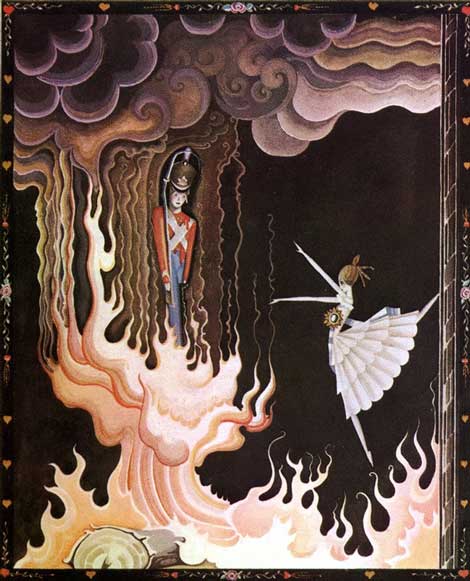Narrative art is art that holds a story in it. It is as old as a simple clay bowl that holds life-giving water. The narrative art that most effected me, at a tender age and for the rest of my life, were the pictures by Kay Nielsen that I saw in my fairy tale book, East of the Sun and West of the Moon. Rather than just illustrating the story, these paintings added to it on a whole other level. They gave the princess the power of beauty and mystery, a past out of a foreign land I knew could never exist, and a wardrobe to die for: part Oriental, part Beardsleyesque yet reminiscent of Nordic mythology. But more than that, these paintings expressed her submission to terrible hardships and merciless men that went way beyond the fairy tale…all of this without a hair out of place and yet very sexual, coupled with the stunning grace of a ballerina. The fairy tale often left all this out because to describe one of Nielsen’s paintings accurately could take a year and no fairy tale can wait that long when its audience is only six. I knew these pictures long before I read the stories and often my interpretations were better—they were certainly crueler and a lot more bloody.
There is another magical power that these story paintings possess; they can throw you willing or unwillingly back into your own past, back to when you first set eyes on them. Within seconds I remember every detail of the library, which in our house was a hallway of about three feet in length, an area you might miss until you remembered that your entire imagination was imprisoned there. Darker memories fly down, sinking their talons into the back of my brain, but there is no escape—once again I have been crying. Our Lord and Father has executed my pet alligator, the one Nana, the wicked witch of West Florida, mailed to my brother and me. In the kitchen, where our dragon is chained to the dishwasher we gave Nana for Christmas, I am forced to wear big ugly brown shoes that the other children in my ritzy private school will laugh at. The smoke of a thousand camels pours out of her glamorous red mouth as I surrender. But I am victorious.
Returning to my miserable pile of straw, I dream of being Nielsen’s ballerina, who fearlessly dances into the fire to save her tin soldier from melting. Oh alligator, my poor alligator, if only I didn’t wear ugly brown shoes I could have been that ballerina, and saved you from the fiery mouth of our apartment’s incinerator.
Now, if this is what a good painting can do to the small brain of a 6-year-old, imagine what Jeff Koons’ balloon dog is doing to your adult brain. Kay Nielsen did two movies for Disney, was fired and spent the rest of his life in poverty. This is also the fate of narrative art. However it was not replaced by conceptual art—it was replaced by the movies. Narrative art makes your imagination create the story, whereas the movies silence your imagination by doing everything for you. All you do is sit in your comfy seat, your mouth full of popcorn, accepting everything from fashion, to sex, to politics, to happiness, while being trained to consume and submit. Well, maybe that’s a little over the top, but we should try making up our own stories. It’s more fun.


